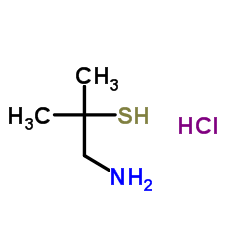1-Amino-2-methylpropane-2-thiol
Modify Date: 2025-08-25 18:42:24

1-Amino-2-methylpropane-2-thiol structure
|
Common Name | 1-Amino-2-methylpropane-2-thiol | ||
|---|---|---|---|---|
| CAS Number | 32047-53-3 | Molecular Weight | 141.663 | |
| Density | 0.936 g/cm3 | Boiling Point | 146.2ºC at 760 mmHg | |
| Molecular Formula | C4H12ClNS | Melting Point | N/A | |
| MSDS | N/A | Flash Point | 42.2ºC | |
| Name | dimethylcysteamine hydrochloride |
|---|---|
| Synonym | More Synonyms |
| Density | 0.936 g/cm3 |
|---|---|
| Boiling Point | 146.2ºC at 760 mmHg |
| Molecular Formula | C4H12ClNS |
| Molecular Weight | 141.663 |
| Flash Point | 42.2ºC |
| Exact Mass | 141.037903 |
| PSA | 64.82000 |
| LogP | 2.15580 |
|
Product Name1-AMINO-2-METHYL-2-PROPANETHIOL HYDRO- &
2 - Hazards Identification SPECIAL INDICATION OF HAZARDS TO HUMANS AND THE ENVIRONMENT Irritating to eyes, respiratory system and skin. 3 - Composition/Information on Ingredients Product NameCAS #EC noAnnex I 1-AMINO-2-METHYL-2-PROPANETHIOL 32047-53-3 NoneNone
HYDRO-CHLORIDE, 97% FormulaC4H11NS Molecular Weight 141,6700 AMU 4 - First Aid Measures AFTER INHALATION If inhaled, remove to fresh air. If not breathing give artificial respiration. If breathing is difficult, give oxygen. AFTER SKIN CONTACT In case of contact, immediately wash skin with soap and copious amounts of water. AFTER EYE CONTACT In case of contact, immediately flush eyes with copious amounts of water for at least 15 minutes. AFTER INGESTION If swallowed, wash out mouth with water provided person is conscious. Call a physician. 5 - Fire Fighting Measures EXTINGUISHING MEDIA Suitable: Water spray. Carbon dioxide, dry chemical powder, or appropriate foam. SPECIAL RISKS Specific Hazard(s): Emits toxic fumes under fire conditions. SPECIAL PROTECTIVE EQUIPMENT FOR FIREFIGHTERS Wear self-contained breathing apparatus and protective clothing to prevent contact with skin and eyes. 6 - Accidental Release Measures PERSONAL PRECAUTION PROCEDURES TO BE FOLLOWED IN CASE OF LEAK OR SPILL Evacuate area. PROCEDURE(S) OF PERSONAL PRECAUTION(S) Wear self-contained breathing apparatus, rubber boots, and heavy rubber gloves. METHODS FOR CLEANING UP Sweep up, place in a bag and hold for waste disposal. Avoid raising dust. Ventilate area and wash spill site after material pickup is complete. 7 - Handling and Storage HANDLING Directions for Safe Handling: Do not breathe dust. Avoid contact with eyes, skin, and clothing. STORAGE Conditions of Storage: Keep tightly closed. Store in a cool dry place. 8 - Exposure Controls / Personal Protection ENGINEERING CONTROLS Safety shower and eye bath. Use only in a chemical fume hood. GENERAL HYGIENE MEASURES Wash thoroughly after handling. Wash contaminated clothing before reuse. PERSONAL PROTECTIVE EQUIPMENT Respiratory Protection: Use respirators and components tested and approved under appropriate government standards such as NIOSH (US) or CEN (EU). Where risk assessment shows air-purifying respirators are appropriate use a dust mask type N95 (US) or type P1 (EN 143) respirator. Hand Protection: Compatible chemical-resistant gloves. Eye Protection: Chemical safety goggles. 9 - Physical and Chemical Properties pH N/A BP/BP RangeN/A MP/MP Range243,000 °C Flash PointN/A FlammabilityN/A Autoignition TempN/A Oxidizing Properties N/A Explosive Properties N/A Explosion LimitsN/A Vapor PressureN/A Partition Coefficient N/A ViscosityN/A Vapor DensityN/A Saturated Vapor Conc. N/A Evaporation RateN/A Bulk DensityN/A Decomposition Temp.N/A Solvent ContentN/A Water ContentN/A Surface TensionN/A ConductivityN/A Miscellaneous DataN/A SolubilityN/A 10 - Stability and Reactivity STABILITY Materials to Avoid: Strong oxidizing agents. HAZARDOUS DECOMPOSITION PRODUCTS Hazardous Decomposition Products: Carbon monoxide, Carbon dioxide, Nitrogen oxides, Sulfur oxides, Hydrogen chloride gas. 11 - Toxicological Information SIGNS AND SYMPTOMS OF EXPOSURE To the best of our knowledge, the chemical, physical, and toxicological properties have not been thoroughly investigated. Nausea, headache, and vomiting. Exposure can cause: ROUTE OF EXPOSURE Inhalation: Material is irritating to mucous membranes and upper respiratory tract. Multiple Routes: May be harmful by inhalation, ingestion, or skin absorption. Causes eye and skin irritation. 12 - Ecological Information No data available. 13 - Disposal Considerations SUBSTANCE DISPOSAL Dissolve or mix the material with a combustible solvent and burn in a chemical incinerator equipped with an afterburner and scrubber. Observe all federal, state, and local environmental regulations. 14 - Transport Information RID/ADR Non-hazardous for road transport. IMDG Non-hazardous for sea transport. IATA UN#: 3335 Class: 9 Proper Shipping Name: Aviation Regulated Solid, N.O.S. Inhalation Packing Group I: No Technical Name: Required 15 - Regulatory Information CLASSIFICATION AND LABELING ACCORDING TO EU DIRECTIVES INDICATION OF DANGER: Xi Irritant. R-PHRASES: 36/37/38 Irritating to eyes, respiratory system and skin. S-PHRASES: 26-36 In case of contact with eyes, rinse immediately with plenty of water and seek medical advice. Wear suitable protective clothing. Caution: Substance not yet fully tested (EU). COUNTRY SPECIFIC INFORMATION Germany WGK: 3 SECTION 16 - ADDITIONAL INFORMATION N/A |
| Hazard Codes | Xi |
|---|---|
| HS Code | 2930909090 |
| HS Code | 2930909090 |
|---|---|
| Summary | 2930909090. other organo-sulphur compounds. VAT:17.0%. Tax rebate rate:13.0%. . MFN tariff:6.5%. General tariff:30.0% |
| 1-Amino-2-methylpropane-2-thiol hydrochloride |
| 2-mercaptoisobutylamine hydrochloride |
| 1-Amino-2-methyl-2-propanethiol hydrochloride (1:1) |
| Z1X1&1&SH &&HCl |
| 1-Amino-2-methyl-propan-2-thiol,Hydrochlorid |
| 1-Amino-2-methyl-2-propanethiol hydrochloride DMCHCL |
| 1-AMINO-2-METHYLPROPANE-2-THIOL |
| 1-Amino-2-methylpropane-2-thiol hydrochloride (1:1) |
| 2-Propanethiol, 1-amino-2-methyl-, hydrochloride (1:1) |
| 1-amino-2-methyl-2-propanthiol-hydrochloride |
| 1-Amino-2-methyl-2-propanethiol hydrochloride |
| DimethylcystamineHcl |

